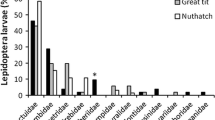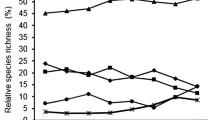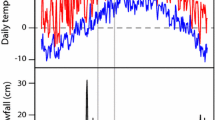Abstract
Large herbivores may modify the ecosystem in a way that affects habitat quality and resource availability for other fauna. The increase in wild ungulate abundance in many areas may therefore lead to ecosystem changes, affecting distribution and reproduction of other species. Moose (Alces alces) in Scandinavia is a good example of a herbivore that has recently increased in abundance and has the potential to affect the ecosystem. In this study, we investigated how different levels of moose winter activity around supplementary feeding stations for moose affect reproduction in two insectivorous passerines: great tits (Parus major) and pied flycatchers (Ficedula hypoleuca). The two bird species showed contrasting responses to high moose activity at feeding stations. Great tits avoided habitats with high moose activity, where fledging success and feeding frequency was lower than at low moose activity habitats. Flycatchers nested more often at high moose activity habitats where fledging weight and feeding frequency were higher than at low moose activity habitats. Filming of nest boxes with great tits showed an increase in adult Lepidoptera in the diet at supplementary feeding stations for moose, and a smaller size of caterpillar prey at intermediate moose activity. The results support the hypothesis that herbivores may affect insectivorous passerines through changed arthropod food availability.



Similar content being viewed by others
References
Allombert S, Gaston AJ, Martin JL (2005a) A natural experiment on the impact of overabundant deer on songbird populations. Biol Conserv 126(1):1–13
Allombert S, Stockton S, Martin JL (2005b) A natural experiment on the impact of overabundant deer on forest invertebrates. Conserv Biol 19(6):1917–1929
Andreassen HP, Gundersen H, Storaas T (2005) The effect of scent-marking, forest clearing, and supplemental feeding on moose-train collisions. J Wildl Manage 69(3):1125–1132
Bailey JK, Whitham TG (2003) Interactions among elk, aspen, galling sawflies and insectivorous birds. Oikos 101(1):127–134
Baines D (1996) The implications of grazing and predator management on the habitats and breeding success of black grouse Tetrao tetrix. J Appl Ecol 33(1):54–62
Berger J, Stacey PB, Bellis L, Johnson MP (2001) A mammalian predator-prey imbalance: grizzly bear and wolf extinction affect avian neotropical migrants. Ecol Appl 11(4):947–960
Bergman KO, Ask L, Askling J, Ignell H, Wahlman H, Milberg P (2008) Importance of boreal grasslands in Sweden for butterfly diversity and effects of local and landscape habitat factors. Biodivers Conserv 17(1):139–153. doi:10.1007/s10531-007-9235-x
BoxCar (1997). 3.0 edn. Onset Computer Corporation, Bourne, MA
Brits J, van Rooyen MW, van Rooyen N (2002) Ecological impact of large herbivores on the woody vegetation at selected watering points on the eastern basaltic soils in the Kruger National Park. Afr J Ecol 40(1):53–60
Burnham KP, Anderson DR (2002) Model selection and multimodel inference: a practical information-theoretic approach. Springer, New York
Cederlund G, Bergström R (1996) Trends in the moose-forest system in Fennoscandia, with special reference to Sweden. In: DeGraaf RM, Miller RI (eds) Conservation of faunal diversity in forested landscapes. Chapman & Hall, London, pp 265–281
Côté SD, Rooney TP, Tremblay JP, Dussault C, Waller DM (2004) Ecological impacts of deer overabundance. Ann Rev Ecol Evol Syst 35:113–147
Cramp S (1977) Handbook of the birds of Europe, the Middle East and North Africa: the birds of the Western Palearctic. Oxford University Press, Oxford
Currie D, Nour N, Adriaensen F (1996) A new technique for filming prey delivered to nestlings, making minmal alterations to the nest box. Bird Study 43:380–382
Danell K, Huss-Danell K (1985) Feeding by insects and hares on birches earlier affected by moose browsing. Oikos 44(1):75–81
Danell K, Bergstrom R, Edenius L, Ericsson G (2003) Ungulates as drivers of tree population dynamics at module and genet levels. For Ecol Manage 181(1–2):67–76
Davidson DW (1993) The effects of herbivory and granivory on terrestrial plant succession. Oikos 68(1):23–35
den Herder M, Bergstrom R, Niemela P, Danell K, Lindgren M (2009) Effects of natural winter browsing and simulated summer browsing by moose on growth and shoot biomass of birch and its associated invertebrate fauna. Ann Zool Fenn 46(1):63–74
Dhondt AA, Kempenaers B, Adriaensen F (1992) Density-dependent clutch size caused by habitat heterogeneity. J Anim Ecol 61(3):643–648
Doligez B, Part T, Danchin E (2004) Prospecting in the collared flycatcher: gathering public information for future breeding habitat selection? Anim Behav 67:457–466. doi:10.1016/j.anbehav.2003.03.010
Evans DM, Redpath SM, Evans SA, Elston DA, Dennis P (2005) Livestock grazing affects the egg size of an insectivorous passerine. Biol Lett 1(3):322–325. doi:10.1098/rsbl.2005.0335
Evans DM, Redpath SM, Evans SA, Elston DA, Gardner CJ, Dennis P, Pakeman RJ (2006) Low intensity, mixed livestock grazing improves the breeding abundance of a common insectivorous passerine. Biol Lett 2(4):636–638. doi:10.1098/rsbl.2006.0543
Fuller RJ (2001) Responses of woodland birds to increasing numbers of deer: a review of evidence and mechanisms. Forestry 74(3):289–298
Fuller RJ, Gill RMA (2001) Ecological impacts of increasing numbers of deer in British woodland. Forestry 74(3):193–199
Garrott RA, White PJ, White CAV (1993) Overabundance—an issue for conservation biologists. Conserv Biol 7(4):946–949
Gundersen H, Andreassen HP, Storaas T (2004) Supplemental feeding of migratory moose Alces alces: forest damage at two spatial scales. Wildlife Biol 10(3):213–223
Hilden O (1965) Habitat selection in birds. Ann Zool Fenn 2:53–75
Hobbs NT (1996) Modification of ecosystems by ungulates. J Wildl Manage 60(4):695–713
Holt CA, Fuller RJ, Dolman PM (2010) Experimental evidence that deer browsing reduces habitat suitability for breeding common nightingales Luscinia megarhynchos. Ibis 152(2):335–346
Loe LE, Mysterud A, Stien A, Steen H, Evans DM, Austrheim G (2007) Positive short-term effects of sheep grazing on the alpine avifauna. Biol Lett 3(1):109–111
Luccarini S, Mauri L, Ciuti S, Lamberti P, Apollonio M (2006) Red deer (Cervus elaphus) spatial use in the Italian Alps: home range patterns, seasonal migrations, and effects of snow and winter feeding. Ethol Ecol Evol 18(2):127–145
Martin JL, Joron M (2003) Nest predation in forest birds: influence of predator type and predator’s habitat quality. Oikos 102(3):641–653
Mathisen KM (2011) Indirect effects of moose on the birds and the bees. Sveriges lantbruksuniversitet, Umeå
Mathisen KM, Skarpe C (2011) Cascading effects of moose (Alces alces) management on birds. Ecol Res 26(3):563–574. doi:10.1007/s11284-011-0815-6
Mathisen KM, Buhtz F, Danell K, Bergstrom R, Skarpe C, Suominen O, Persson IL (2010) Moose density and habitat productivity affects reproduction, growth and species composition in field layer vegetation. J Veg Sci 21(4):705–716. doi:10.1111/j.1654-1103.2010.01180.x
McShea WJ, Rappole JH (2000) Managing the abundance and diversity of breeding bird populations through manipulation of deer populations. Conserv Biol 14(4):1161–1170
McShea WJ, Underwood HB, Rappole JH (1997) The science of overabundance: deer ecology and population management. Smithsonian Institution Press, Washington, D.C
Miller BK, Litvaitis JA (1992) Use of roadside salt licks by moose, Alces-alces, in Northern New-Hampshire. Can Field-Nat 106(1):112–117
Moen A, Lillethun A, Odland A (1999) Vegetation. Norwegian Mapping Authority, Hønefoss
Naef-Daenzer L, Naef-Daenzer B, Nager RG (2000) Prey selection and foraging performance of breeding great tits Parus major in relation to food availability. J Avian Biol 31(2):206–214
NMI (2008) eKlima. Norwegian Meterological Institute. http://eklima.met.no
Nour N, Currie D, Matthysen E, Van Damme R, Dhondt AA (1998) Effects of habitat fragmentation on provisioning rates, diet and breeding success in two species of tit (great tit and blue tit). Oecologia 114(4):522–530
Olff H, Ritchie ME (1998) Effects of herbivores on grassland plant diversity. Trends Ecol Evol 13(7):261–265
Pastor J, Cohen Y (1997) Herbivores, the functional diversity of plants species, and the cycling of nutrients in ecosystems. Theor Popul Biol 51(3):165–179
Pastor J, Naiman RJ (1992) Selective foraging and ecosystem processes in boreal forests. Am Nat 139(4):690–705
Pedersen S, Nilsen EB, Andreassen HP (2007) Moose winter browsing affects the breeding success of great tits. Ecoscience 14(4):499–506
Persson I-L (2003) Moose population density and habitat productivity as drivers of ecosystem processes in northern boreal forests. Dr. scient. thesis, Acta Universitatis Agriculturae Suecicae. Silvestria 272 Swedish University of Agricultural Sciences, Umeå
Persson I-L, Danell K, Bergstrom R (2000) Disturbance by large herbivores in boreal forests with special reference to moose. Ann Zool Fenn 37(4):251–263
Persson I-L, Danell K, Bergstrom R (2005) Different moose densities and accompanied changes in tree morphology and browse production. Ecol Appl 15(4):1296–1305
Persson I-L, Bergstrom R, Danell K (2007) Browse biomass production and regrowth capacity after biomass loss in deciduous and coniferous trees: responses to moose browsing along a productivity gradient. Oikos 116(10):1639–1650
Putman RJ, Staines BW (2004) Supplementary winter feeding of wild red deer Cervus elaphus in Europe and North America: justifications, feeding practice and effectiveness. Mammal Rev 34(4):285–306
R Development Core Team (2009) R: a language and environment for statistical computing. R Foundation for Statistical Computing, Vienna, Austria
Riipi M, Lempa K, Haukioja E, Ossipov V, Pihlaja K (2005) Effects of simulated winter browsing on mountain birch foliar chemistry and on the performance of insect herbivores. Oikos 111(2):221–234
Sanz JJ (1998) Effect of habitat and latitude on nestling diet of pied flycatchers Ficedula hypoleuca. Ardea 86(1):81–88
Shadish WR, Cook TD, Campbell DT (2002) Experimental and quasi-experimental designs for generalized causal inference. Houghton Mifflin, Boston
Slagsvold T (1975) Competition between the great tit Parus major and the pied flycatcher Ficedula hypoleuca in the breeding season. Ornis Scand 6:179–190
Slagsvold T, Wiebe KL (2007) Hatching asynchrony and early nestling mortality: the feeding constraint hypothesis. Anim Behav 73:691–700. doi:10.1016/j.anbehav.2006.05.021
Solbraa K (2002) Veiledning i elgbeitetaksering. Skogbrukets kursinstitutt, Biri
Stewart AJA (2001) The impact of deer on lowland woodland invertebrates: a review of the evidence and priorities for future research. Forestry 74(3):259–270
Storaas T, Nicolaysen KB, Gundersen H, Zimmermann B (2005) Prosjekt Elg - trafikk i Stor-Elvdal 2000–2004 hvordan unngå elgpåkjørsler på vei og jernbane. Oppdragsrapport vol 1-2005. Høgskolen i Hedmark
Stowe TJ (1984) Pied flycatcher and wood warbler. Ibis 126(3):454–454
Suominen O, Danell K (2006) Effects of large herbivores on other fauna. In: Danell K, Bergstrom R, Duncan P, Pastor J (eds) Large herbivore ecology, ecosystem dynamics and conservation. Cambridge University, Cambridge, UK, pp 383–407
Suominen O, Persson I-L, Danell K, Bergström R, Pastor J (2008) Impact of simulated moose densities on abundance and richness of vegetation, herbivorous and predatory arthropods along a productivity gradient. Ecography 31(5):636–645
Torgersen S (2008) Effects of moose density and supplementary feeding on field layer vegetation. MSc Thesis, Hedmark University College, Evenstad
van Beest FM, Gundersen H, Mathisen KM, Milner JM, Skarpe C (2010) Long-term browsing impact around diversionary feeding stations for moose in Southern Norway. For Ecol Manage 259:1900–1911
Zuur AF, Ieno EN, Walker NJ, Saveliev AA, Smith GM (2009) Mixed effects models and extensions in ecology with R. Springer, New York
Acknowledgments
This study was funded by Hedmark University College and the Norwegian Research Council. We are grateful to the landowners and the landowner association in Stor-Elvdal municipality and especially Knut Nicolaysen, for support, providing information about moose feeding, and giving us permission to put up nest boxes. Thanks go to the numerous students that have been a great help in the field. Thanks to Harry Andreassen for help with planning this study, to Tom Hætta for going through the video films, to Kjell Danell for helpful comments on the manuscript, to Tore Slagsvold for advice on filming of nest boxes and bird ecology, and to Jos Milner for language corrections. Thanks also to Anders Lamberg for building the nest box loggers and to Stephen Parfitt for maintaining them.
Ethical standards
The practices applied in this study comply with the laws of Norway.
Conflict of interest
We have no conflicts of interest.
Author information
Authors and Affiliations
Corresponding author
Additional information
Communicated by C. Gortázar
Electronic supplementary material
Below is the link to the electronic supplementary material.
ESM 1
Moose browsing pressure and moose pellet density at the different distances to supplementary feeding stations in the years 2004, 2006, and 2007 (DOC 52 kb)
ESM 2
Vegetation and habitat variables at different distance categories to supplementary feeding stations for moose, measured in 2007 (DOC 52 kb)
Rights and permissions
About this article
Cite this article
Mathisen, K.M., Pedersen, S., Nilsen, E.B. et al. Contrasting responses of two passerine bird species to moose browsing. Eur J Wildl Res 58, 535–547 (2012). https://doi.org/10.1007/s10344-011-0601-3
Received:
Revised:
Accepted:
Published:
Issue Date:
DOI: https://doi.org/10.1007/s10344-011-0601-3




